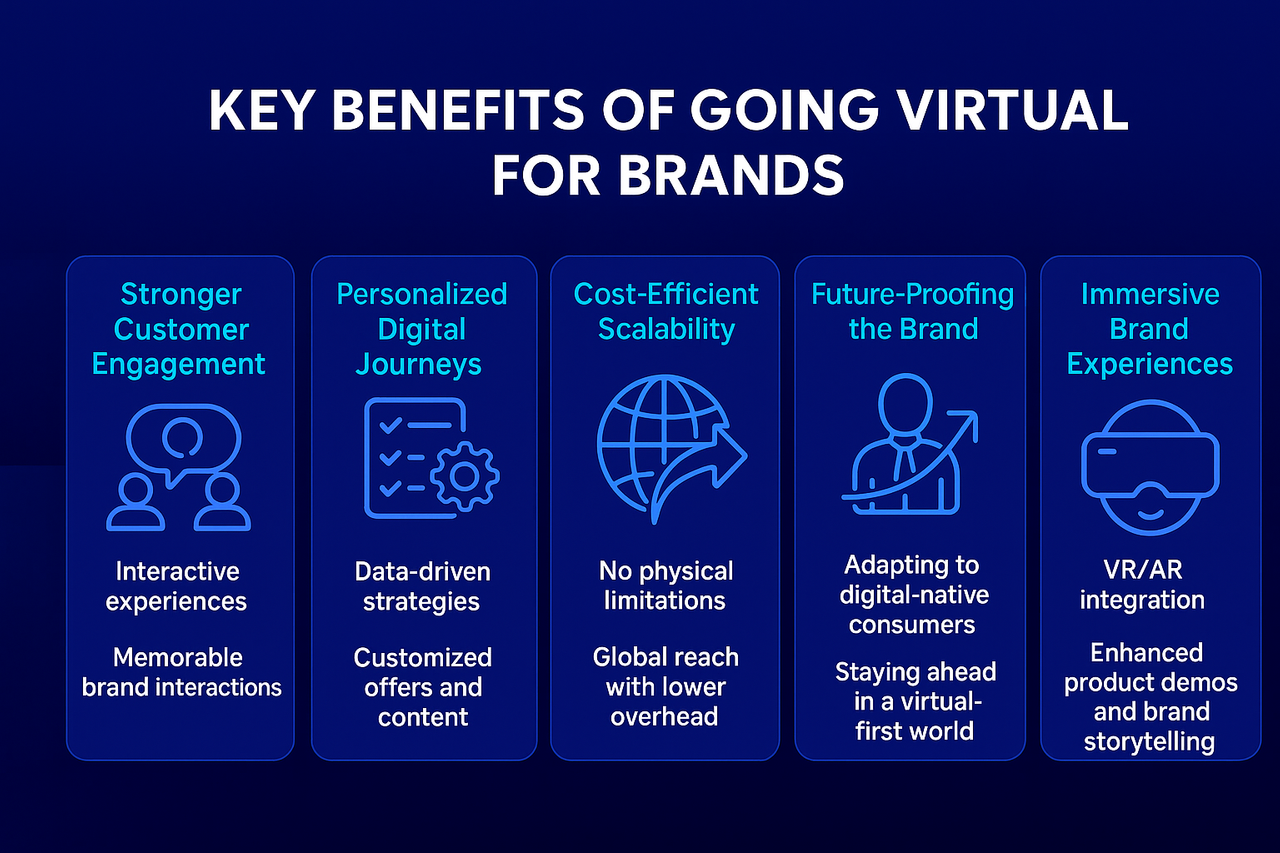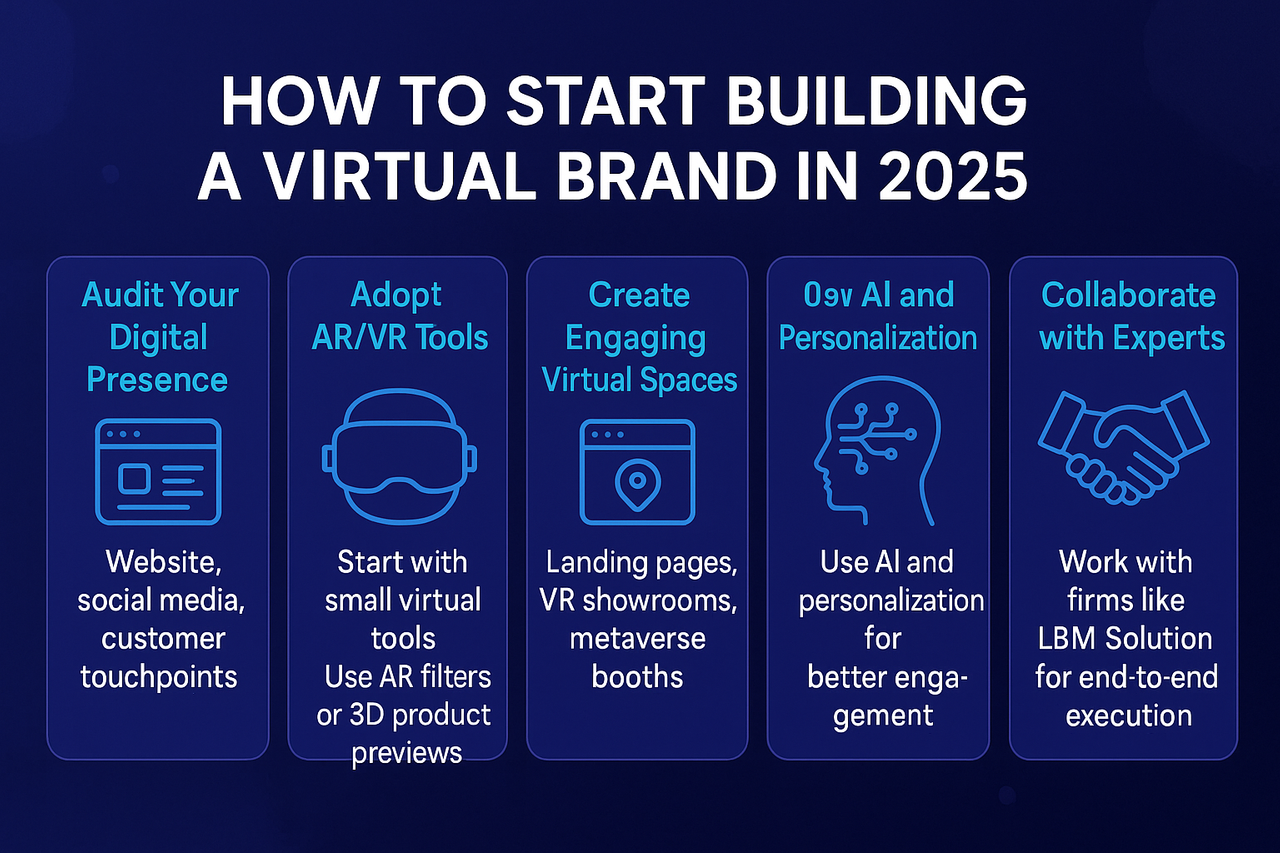In 2025, we’re witnessing a tipping point in how businesses operate and connect with consumers. The rise of immersive tech, shifting consumer behaviors, and a digitally native generation have driven a massive shift: brands are going virtual not just with their marketing, but with entire business models.
This isn’t a trend reserved for tech giants. Startups, fashion labels, B2B companies, and even local service providers are investing in Virtual Business Trends 2025 to stay ahead. But what does "going virtual" really mean, and why is it becoming a strategic necessity?
The Virtual Shift: What Does “Going Virtual” Really Mean?
At its core, going virtual means digitizing key parts of a business—be it marketing, customer experience, sales, or service delivery. It’s about creating virtual spaces for businesses where consumers can engage with your brand without stepping into a physical store.
From online brand building through social platforms and metaverse storefronts, to entire businesses operating solely in virtual environments, brands are embracing this evolution as a long-term shift, not just a trend.
Why Brands Are Going Virtual in 2025: The Driving Forces
Several forces are propelling the adoption of virtual models in 2025. Here’s what’s fueling the movement:
1. A Digitally Native Consumer Base
The modern customer expects instant, digital-first experiences. They live on social platforms, explore brands through AR filters, and attend virtual events. Meeting them where they are requires brands to create seamless digital experience strategies.
2. Advances in Virtual Reality (VR) and Augmented Reality (AR)
Technologies like Virtual Reality for Brands are no longer niche. With accessible headsets and smartphone AR, brands can offer immersive shopping, virtual try-ons, product demos, and even training environments.
3. Global Reach and Lower Operational Costs
Operating virtually means businesses can expand globally without the traditional overhead of physical expansion. Virtual business expansion allows brands to test markets, launch virtual stores, or host global product launches with significantly reduced costs.
4. Evolution of the Metaverse
While the buzz around the metaverse has matured, brand growth in the metaverse is becoming more strategic. Instead of gimmicks, companies are building long-term communities and loyalty programs within persistent digital worlds.
Real-World Examples of the Virtual Brand Boom
Let’s look at a few examples illustrating how businesses are leveraging these shifts:
Nike’s Virtual Storefronts: Nike’s “.Swoosh” platform offers limited-edition digital collectibles, community engagement, and metaverse events all part of their virtual branding efforts.
Ralph Lauren in Roblox: The fashion brand launched a fully branded world on Roblox, where users can shop digital fashion and attend virtual experiences, boosting digital customer engagement.
Small Businesses with AR Catalogs: From furniture retailers offering in-room previews to beauty brands with AR makeup trials, even small and mid-size businesses are leveraging virtual tools.
These examples show how brands are using immersive brand experiences to build loyalty and engagement that’s difficult to achieve through traditional channels.
Key Benefits of Going Virtual for Brands
The shift isn’t just hype it delivers measurable value:
1. Stronger Engagement
Virtual platforms enable more interactive and memorable experiences. Whether it’s a VR product tour or a metaverse concert, customers remember how you made them feel, boosting both brand recall and advocacy.
2. Data-Driven Personalization
Digital platforms collect rich data on customer behavior. With the right tools, brands can build personalized journeys and content strategies that feel human and relevant.
3. Scalability and Flexibility
Virtual models can scale faster than physical ones. A brand launching in a virtual world doesn’t need to worry about real estate, logistics, or local permits it can scale instantly.
4. Future-Proofing the Business
By embracing virtual business trends in 2025, brands are positioning themselves for what’s next. The digital economy is only going to deepen, and those who invest early will lead.

Emerging Virtual Marketing Trends to Watch in 2025
Marketing is evolving rapidly, and 2025 is seeing major leaps:
- Virtual Showrooms
Instead of browsing static product pages, users can enter immersive 3D environments, view products up close, and even interact with sales avatars.
- Interactive Livestream Commerce
Brands are blending video, chat, and shopping into one. Think of it as QVC meets Twitch real-time sales, influencer hosting, and direct consumer interaction.
- AI-Driven Personalization Engines
AI tools are powering digital experience strategies, adapting content and offers based on real-time signals to improve conversion and engagement.
- Virtual Events & Branded Worlds
More brands are hosting virtual events in metaverse platforms like Decentraland or Meta Horizon Worlds. These aren't one-off stunts but full-fledged branding plays for online brand building.
How to Start Building Your Virtual Brand in 2025
Going virtual might sound complex, but you don’t need a Fortune 500 budget to get started. Here's a simplified approach:
1. Audit Your Digital Presence
Review your current website, social media, and content strategies. Are they optimized for engagement, interaction, and storytelling?
2. Explore AR/VR Tools
Start small, use AR filters on Instagram or offer 3D product views on your site. Gradually scale into virtual reality for brands if it fits your product category.
3. Create Virtual Brand Spaces
This could be as simple as an interactive landing page or as bold as a VR showroom. Either way, make it on-brand and consumer-focused.
4. Invest in Digital Community Building
Whether on Discord, Reddit, or inside a metaverse world, engaged communities drive word-of-mouth and loyalty.
5. Partner with Experts
Companies like LBM Solution specialize in helping brands navigate this shift with end-to-end digital strategy, virtual development, and customer engagement solutions.

Conclusion: Virtual Is No Longer Optional
In 2025, going virtual isn’t just a competitive advantage, it's becoming a baseline expectation. Brands that embrace virtual business trends 2025 are unlocking new ways to grow, engage, and scale. Whether it’s through immersive brand experiences, digital customer engagement, or building spaces in the metaverse, the future belongs to those who innovate beyond the physical.




